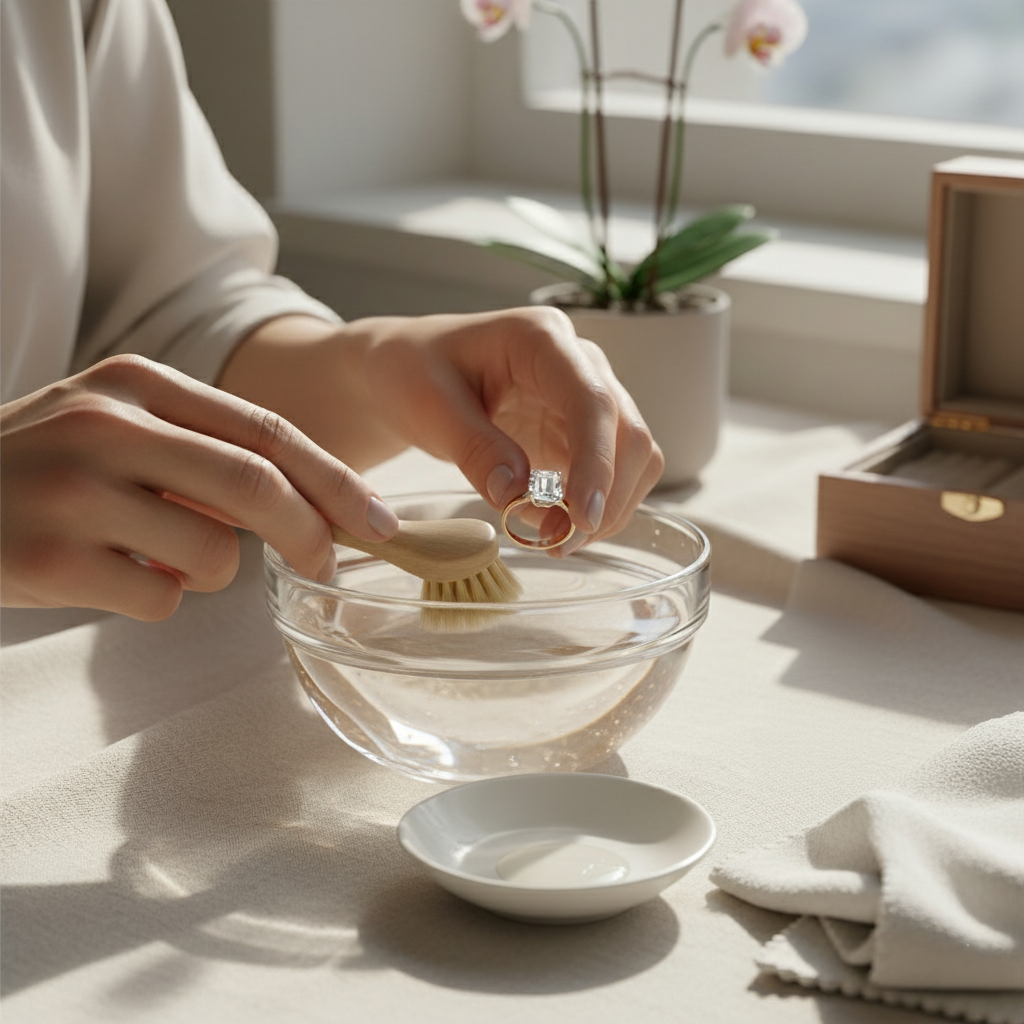
How to Care for Your Engagement Ring: The Georgina Jewels Guide to a Lifetime of Brilliance
Share
An engagement ring is a modern heirloom and a symbol of a lasting promise, and its enduring brilliance requires mindful care. This guide provides a comprehensive overview of how to protect your cherished piece, from simple weekly cleanings to essential professional maintenance.
The Art of At-Home Cleaning
A consistent, gentle cleaning ritual is the most effective way to maintain your ring's sparkle by preventing the buildup of oils and grime. Performed weekly, this simple process restores the vibrant life of your ring. Before you begin, assemble a small bowl of warm water with a few drops of mild, degreasing dish soap, a new soft-bristled toothbrush reserved only for jewelry, and a soft, lint-free cloth for drying.
- Soak: The primary purpose of this method is to break down oils from skin, lotions, and makeup. Place your ring in the soapy solution for 20 to 40 minutes, allowing the soap to lift greasy residues.
- Detail: After soaking, use the soft toothbrush to gently dislodge any remaining particles from hard-to-reach areas, especially the underside of the gemstone and within the setting. Avoid aggressive scrubbing, which can scratch softer metals or weaken delicate settings. If you notice a stone is loose, do not brush it and take it to a jeweler immediately.
- Rinse and Dry: Rinse the ring thoroughly under warm running water, making sure to close or plug the sink drain first. Gently pat the ring dry with your lint-free cloth to prevent water spots and restore its shine.
A Guide to Gemstones and Metals
While the soap-and-water method is a great standard, different materials require specific care. Understanding your ring’s metal and gemstones is key to its preservation.
Caring for Precious Metals
- Platinum, Yellow Gold, and Rose Gold: These robust metals respond beautifully to the standard warm soap-and-water cleaning method.
- White Gold: Most white gold is plated with rhodium for a hard, bright-white finish. This plating can wear away over time, so it is crucial to avoid abrasive cleaners. White gold should be professionally re-plated every one to three years to restore its original brilliance.
- Sterling Silver: This softer metal is prone to tarnishing. While soap and water work for light cleaning, significant tarnish may require a specific, non-abrasive silver cleaner.
Specialized Gemstone Care
The hardness of a gemstone and any treatments it may have received dictate its care protocol.
|
Gemstone |
Mohs Hardness |
Safe At-Home Cleaning |
Ultrasonic/Steam Safe? |
Key Precautions |
|
Diamond |
10 |
Warm water, mild soap, soft brush |
Yes |
Avoid hard impacts that can cause chipping. |
|
Sapphire/Ruby |
9 |
Warm water, mild soap, soft brush |
Usually. No if fracture-filled. |
Avoid harsh chemicals and extreme temperature changes. |
|
Emerald |
7.5 - 8 |
Lukewarm water, mild soap, gentle wipe. No soaking. |
No. Can damage common oil/resin treatments. |
Very sensitive to heat, chemicals, and pressure. |
|
Opal |
5.5 - 6.5 |
Damp cloth with mild soap. Do not soak. |
No. Vulnerable to heat and vibration. |
Porous and can dry out or crack from temperature changes. |
|
Pearl |
2.5 - 4.5 |
Wipe with a soft, damp cloth. No soaking. |
No. An organic gem damaged by vibrations. |
Extremely sensitive to acids, chemicals, and dryness. |
The Golden Rules of Daily Wear
Preventative care is the most effective approach to protecting your ring from physical impact and chemical exposure.
- "Last On, First Off": Make your ring the last thing you put on after cosmetics, hairspray, and lotions, and the first thing you take off. This practice minimizes exposure to chemicals that create a dulling film and can corrode metals or damage porous gems.
- Ring-Free Activities: It is wise to remove your ring before sleeping, showering, cleaning, cooking, or exercising. These activities pose risks of snagging prongs, exposure to harsh chemicals, physical impact, or loss.
- Hidden Dangers: Chlorine is a primary enemy of fine jewelry, as it can corrode the alloys in gold, making the metal brittle and weak. Always remove your ring before entering a pool or hot tub. Cold water in pools and oceans can cause fingers to shrink, increasing the risk of the ring slipping off. Hand sanitizer can also dull the finish of metal and damage organic gems over time.
A Safe Haven for Your Ring
Proper storage protects your ring from damage and loss when it is not being worn. Since a diamond can easily scratch other metals and gemstones, store your ring in a fabric-lined jewelry box with separate compartments. To prevent accidental loss during brief moments when the ring is removed, establish "safe zones" by placing dedicated ring dishes on your nightstand, in the bathroom away from the sink, and on a kitchen shelf. When traveling, always keep your ring in your carry-on bag, preferably in a compact travel jewelry case, and use the hotel safe.
The Professional Touch
While at-home care maintains daily sparkle, a biannual wellness check with a professional jeweler is essential for long-term security. A jeweler can spot signs of wear invisible to the naked eye, such as loose prongs, unstable stones, or cracks in the metal. This preventative check is often required to keep jewelry insurance policies valid. Professionals also use ultrasonic cleaners and high-pressure steam to achieve a level of brilliance that cannot be replicated at home.
You are the first line of defense in your ring's care. Learn to spot trouble by holding the ring to your ear and tapping it gently; a rattling sound indicates a loose stone. If a prong begins to snag on clothing, it may be bent or broken. Regular visual inspections under bright light can help you identify worn prongs or shifted stones. By combining a routine of gentle cleaning, mindful daily habits, safe storage, and a partnership with a trusted jeweler, you ensure your modern heirloom will shine brightly for a lifetime.
